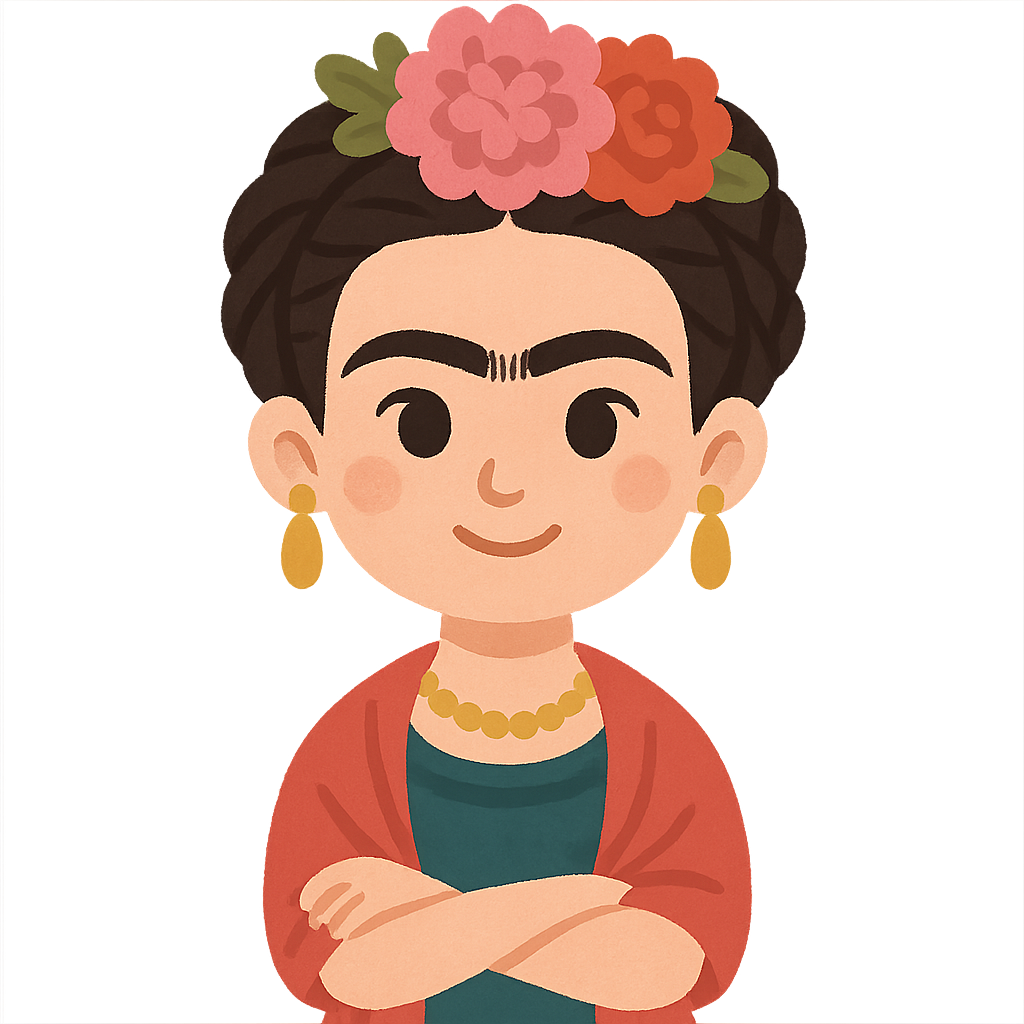Frida Kahlo
Hello. My name is Frida Kahlo, and I am a painter. My story begins not on a canvas, but inside a brilliant blue house, my Casa Azul, in a beautiful neighborhood called Coyoacán in Mexico City. I was born on July 6, 1907, into a world buzzing with color and change. My father, Guillermo, was a talented photographer, and from him, I learned to look at the world with an artist’s careful eye. He taught me to notice the details, the light, and the shadows in everything. My mother, Matilde, was of Spanish and Indigenous descent, and she filled our home with the rich traditions of our Mexican heritage. My childhood was not without its shadows, however. When I was only six years old, I contracted a disease called polio. It left my right leg thinner and weaker than my left, and some children called me cruel names. Instead of letting it defeat me, the experience forged a deep resilience in me. It taught me to be a fighter. As I grew, my dreams were not of painting, but of science. I wanted to be a doctor. I was one of only thirty-five girls among two thousand students at the prestigious National Preparatory School. The school was a whirlwind of new ideas, politics, and art, and I threw myself into my studies with passion, ready to heal the world.
Everything I had planned for my life changed in an instant. On September 17, 1925, when I was eighteen years old, I was riding a bus home from school. The air was warm, the city was alive, and my mind was full of thoughts about my future. Suddenly, there was a terrible crash. The bus I was on collided with a streetcar. The accident was devastating and left me with injuries so severe that doctors doubted I would survive. My dream of becoming a doctor was shattered along with my body. I spent the next year in agonizing pain, confined to my bed and encased in a plaster corset to hold my broken spine together. The boredom was almost as difficult as the pain. I felt trapped, not just in my cast, but in my own room. Seeing my despair, my mother had a special easel built that could fit over my bed, and she placed a mirror above me so I could see myself. My father, remembering my love for detail, gave me his box of oil paints and brushes. With nothing else to do and no other subject to observe, I began to paint. I painted the person I saw in the mirror. I painted myself.
I poured all of my pain, my questions, and my identity onto the canvas. I once said, “I paint my own reality,” and that became the guiding principle of my art. After I had recovered enough to walk again, I gathered a few of my paintings and went to find the most famous artist in Mexico, the great muralist Diego Rivera. I was nervous, but I boldly asked for his honest opinion of my work. He saw something special in my art, a raw and powerful honesty. He encouraged me to continue painting, and that meeting sparked a great, complicated love between us. We were married in 1929. Our life together was a whirlwind of art, travel, and politics, taking us from Mexico to the United States and back again. Through it all, my art was my constant companion, my diary. I didn’t paint dreams; I painted my life. My self-portraits were filled with symbols from Mexican folk art, like monkeys, hummingbirds, and flowers, each with a special meaning. I painted my physical and emotional pain, but I also painted my strength and my love for my culture. I painted myself over and over because, as I often said, “I am the subject I know best.”
My life was a constant negotiation with pain. I endured more than thirty operations over the years, yet I refused to let my physical suffering define my spirit. I found joy in my garden at the Casa Azul, in my pets, and most of all, in my art. I continued to paint with a fierce passion, creating works that were uniquely mine. One of the proudest moments of my life came in 1953, when I was finally given my first solo exhibition in my home country of Mexico. By then, my health was so fragile that my doctors forbade me from getting out of bed. But I was not going to miss my own party. I had my grand four-poster bed moved from my home to the gallery, and I arrived by ambulance. I spent the entire evening there, in my bed, talking and celebrating with my guests. It was a declaration that my spirit could not be broken. Just one year later, on July 13, 1954, my life came to an end in the same blue house where it began. But my story did not end there. I hope that when you see my paintings, you see more than just a face. I hope you see a life lived with passion and honesty. My message to you is to embrace everything that makes you unique—your joys and your struggles. Find the strength in your own reality, and live your life with color and courage.
Reading Comprehension Questions
Click to see answer
